Does the Policy of Decoupled Subsidies Improve the Agricultural Economic Resilience?—Evidence from China’s Main Corn Producing Regions
Abstract
1. Introduction
2. Conceptualizing the Relationship between Agricultural Policy and Agricultural Economic Resilience
2.1. Public Policy and Resilience
2.2. Study Area and Policy Background
2.3. Resilience of Agricultural Economy under the Context of Agricultural Policy Adjustment
3. Methodology
3.1. Data Source
3.2. Research Methodology
- (1)
- Measure of regional agricultural economic resilience.
- (2)
- Geographical detector.
4. Results
4.1. Stage Features of Agricultural Economic Resilience in Jilin Province
4.2. Characteristics of Spatial-Temporal Differentiation in Agricultural Economic Resilience across Cities in Jilin Province
4.3. Detection of Influencing Factors
4.3.1. Detection Result of Influencing Factors
4.3.2. Analysis of the Interaction of Influencing Factors
5. Discussion
6. Conclusions
Author Contributions
Funding
Institutional Review Board Statement
Informed Consent Statement
Data Availability Statement
Acknowledgments
Conflicts of Interest
References
- Arjun, K.M. Indian agriculture-status, importance and role in Indian economy. Int. J. Agric. Food Sci. Technol. 2013, 4, 343–346. [Google Scholar]
- Stanciu, S.; Virlanuta, F.O.; Dinu, V.; Zungan, D.; Antohi, V.M. The perception of the social economy by agricultural producers in the north-east development region of romania. Transform. Bus. Econ. 2019, 18, 879–899. [Google Scholar]
- Marinov, P. Index of localization of agricultural holdings and employees in the rural areas of the South Central Region for Bulgaria. Bulg. J. Agric. 2019, 25, 464–467. [Google Scholar]
- Thurlow, J.; Dorosh, P.; Davis, B. Demographic change, agriculture, and rural poverty. Sustain. Food Agric. 2019, 2019, 31–53. [Google Scholar]
- Shabanov, V.L.; Vasilchenko, M.Y.; Derunova, E.A.; Potapov, A.P. Formation of an export-oriented agricultural economy and regional open innovations. J. Open Innov. Technol. Mark. Complex. 2021, 7, 32. [Google Scholar] [CrossRef]
- Makate, C.; Makate, M.; Mango, N.; Siziba, S. Increasing resilience of smallholder farmers to climate change through multiple adoption of proven climate-smart agriculture innovations. Lessons from Southern Africa. J. Environ. Manag. 2019, 231, 858–868. [Google Scholar] [CrossRef] [PubMed]
- Darnhofer, I. Resilience or how do we enable agricultural systems to ride the waves of unexpected change? Agric. Syst. 2021, 187, 102997. [Google Scholar] [CrossRef]
- Adelaja, A.; George, J. Effects of conflict on agriculture: Evidence from the Boko Haram insurgency. World Dev. 2019, 117, 184–195. [Google Scholar] [CrossRef]
- Lioutas, E.D.; Charatsari, C. Enhancing the ability of agriculture to cope with major crises or disasters: What the experience of COVID-19 teaches us. Agric. Syst. 2021, 187, 103023. [Google Scholar] [CrossRef]
- Garrone, M.; Emmers, D.; Lee, H.; Olper, A.; Swinnen, J. Subsidies and agricultural productivity in the EU. Agric. Econ. 2019, 50, 803–817. [Google Scholar] [CrossRef]
- Saifi, B.; Drake, L. A coevolutionary model for promoting agricultural sustainability. Ecol. Econ. 2008, 65, 24–34. [Google Scholar] [CrossRef]
- Folke, C. Resilience (republished). Ecol. Soc. 2016, 21, 44. [Google Scholar] [CrossRef]
- Bullock, J.M.; Dhanjal-Adams, K.L.; Milne, A.; Oliver, T.H.; Todman, L.C.; Whitmore, A.P.; Pywell, R.F. Resilience and food security: Rethinking an ecological concept. J. Ecol. 2017, 105, 880–884. [Google Scholar] [CrossRef]
- Volkov, A.; Žičkienė, A.; Morkunas, M.; Baležentis, T.; Ribašauskienė, E.; Streimikiene, D. A Multi-Criteria Approach for Assessing the Agricultural economic resilience: The Case of Lithuania. Sustainability 2021, 13, 2370. [Google Scholar] [CrossRef]
- Volkov, A.; Morkunas, M.; Balezentis, T.; Streimikiene, D. Are agricultural sustainability and resilience complementary notions? Evidence from the North European agriculture. Land Use Policy 2022, 112, 105791. [Google Scholar] [CrossRef]
- Johnson, D.G. World Agriculture in Disarray; Palgrave Macmillan: London, UK, 1973. [Google Scholar]
- Meuwissen, M.P.M.; Paas, W.H.; Slijper, T.; Coopmans, I.; Ciechomska, A.; Lievens, E.; Deckers, J.; Vroege, W.; Mathijs, E.; Kopainsky, B.; et al. Report on Resilience Framework for EU Agriculture: Sustainable and Resilient EU Farming Systems (SureFarm) Project Report, Work Package D1. 1; Wageningen University & Research: Wageningen, The Netherlands, 2018. [Google Scholar]
- Leibenstein, H. Allocative Efficiency vs. ‘X-Efficiency. Am. Econ. Rev. 1966, 56, 392–415. [Google Scholar]
- Ciaian, P.; Swinnen, J. Credit Market Imperfections and the Distribution of Policy Rents. Am. J. Agric. Econ. 2009, 91, 1124–1139. [Google Scholar] [CrossRef]
- Quendler, E.; Morkūnas, M. The economic resilience of the Austrian Agriculture since the EU accession. J. Risk Financ. Manag. 2020, 13, 236. [Google Scholar] [CrossRef]
- Guyomard, H.; Le Mouël, C.; Gohin, A. Impacts of Alternative Agricultural Income Support Schemes on Multiple Policy Goals. Eur. Rev. Agric. Econ. 2004, 31, 125–148. [Google Scholar] [CrossRef]
- Alston, J.M.; James, J.S. The incidence of agricultural policy. Handb. Agric. Econ. 2002, 2, 1689–1749. [Google Scholar]
- Rizov, M.; Pokrivcak, J.; Ciaian, P. CAP subsidies and productivity of the EU farms. J. Agric. Econ. 2013, 64, 537–557. [Google Scholar] [CrossRef]
- Kazukauskas, A.; Newman, C.; Sauer, J. The Impact of Decoupled Subsidies on Productivity in Agriculture: A Cross-Country Analysis Using Microdata. Agric. Econ. 2014, 45, 327–336. [Google Scholar] [CrossRef]
- Minviel, J.J.; Latruffe, L. Effect of public subsidies on farm technical efficiency: A meta-analysis of empirical results. Appl. Econ. 2017, 49, 213–226. [Google Scholar] [CrossRef]
- Howlett, M. Designing Public Policies: Principles and Instruments, 2nd ed.; Routledge: Abingdon, UK; New York, NY, USA, 2019. [Google Scholar]
- Ashkenazy, A.; Chebach, T.C.; Knickel, K.; Peter, S.; Horowitz, B.; Offenbach, R. Operationalising resilience in farms and rural regions—Findings from fourteen case studies. J. Rural Stud. 2017, 59, 211–221. [Google Scholar] [CrossRef]
- Martin, R.; Sunley, P.; Gardiner, B.; Tyler, P. How regions react to recessions: Resilience and the role of economic structure. Reg. Stud. 2016, 50, 561–585. [Google Scholar] [CrossRef]
- Manca, A.R.; Benczur, P.; Giovannini, E. Building a Scientific Narrative towards a More Resilient EU Society; JRC Science for Policy Report; European Union: Luxembourg, 2017; p. 137. [Google Scholar]
- Mary, S. Assessing the impacts of pillar 1 and 2 subsidies on TFP in French crop farms. J. Agric. Econ. 2013, 64, 133–144. [Google Scholar] [CrossRef]
- Buitenhuis, Y.; Candel, J.J.; Termeer, K.J.; Feindt, P.H. Does the Common Agricultural Policy enhance farming systems’ resilience? Applying the Resilience Assessment Tool (ResAT) to a farming system case study in the Netherlands. J. Rural. Stud. 2020, 80, 314–327. [Google Scholar] [CrossRef]
- Hammond, B.; Berardi, G.; Green, R. Resilience in Agriculture: Small-and medium-sized farms in Northwest Washington State. Agroecol. Sustain. Food Syst. 2013, 37, 316–339. [Google Scholar] [CrossRef]
- Walker, B.; Holling, C.S.; Carpenter, S.R.; Kinzig, A. Resilience, adaptability and transformability in social–ecological systems. Ecol. Soc. 2004, 9, 5. [Google Scholar] [CrossRef]
- Meuwissen, M.P.; Feindt, P.H.; Spiegel, A.; Termeer, C.J.; Mathijs, E.; De Mey, Y.; Finger, R.; Balmann, A.; Wauters, E.; Urquhart, J.; et al. A framework to assess the resilience of farming systems. Agric. Syst. 2019, 176, 102656. [Google Scholar] [CrossRef]
- Xu, Z.G.; Xi, Y.S.; Zhang, S.H. Analysis on the implementation of national temporary corn purchase and storage policy in 2009/2009. Issues Agric. Econ. 2010, 31, 16–23+110. [Google Scholar]
- Cao, H.; Zhang, Y.; Sun, H. The Potential Impacts of Reforming China’s Floor Price Policies on Grains. Chin. Rural. Econ. 2017, 11, 33–46. [Google Scholar]
- Li, L.; Zhang, P.; Tan, J.; Guan, H. Review on The Evolution of Resilience Concept and Research Progress on Regional Economic Resilience. Hum. Geogr. 2019, 34, 1–7+151. [Google Scholar]
- Holling, C.S. Resilience and stability of ecological systems. Annu. Rev. Ecol. Syst. 1973, 4, 1–23. [Google Scholar] [CrossRef]
- Martin, R. Regional economic resilience, hysteresis and recessionary shocks. J. Econ. Geogr. 2012, 12, 1–32. [Google Scholar] [CrossRef]
- Angulo, A.M.; Mur, J.; Trívez, F.J. Measuring resilience to economic shocks: An application to Spain. Ann. Reg. Sci. 2018, 60, 349–373. [Google Scholar] [CrossRef]
- Ahearn, M.C.; El-Osta, H.; Dewbre, J. The impact of coupled and decoupled government subsidies on off-farm labor participation of US farm operators. Am. J. Agric. Econ. 2006, 88, 393–408. [Google Scholar] [CrossRef]
- Desa, U.N. Transforming Our World: The 2030 Agenda for Sustainable Development; United Nations: New York, NY, USA, 2016. [Google Scholar]
- Allison, H.E.; Hobbs, R.J. Resilience, adaptive capacity, and the “lock-in trap” of the Western Australian agricultural region. Ecol. Soc. 2004, 9, 3. [Google Scholar] [CrossRef]
- Li, L.; Zhang, P.; Lo, K.; Liu, W.; Li, J. The evolution of regional economic resilience in the old industrial bases in China: A case study of Liaoning Province, China. Chin. Geogr. Sci. 2020, 30, 340–351. [Google Scholar] [CrossRef]
- Hu, X.; Li, L.; Dong, K. What matters for regional economic resilience amid COVID-19? Evidence from cities in Northeast China. Cities 2022, 120, 103440. [Google Scholar] [CrossRef]
- Davies, S. Regional resilience in the 2008–2010 downturn: Comparative evidence from European countries. Camb. J. Reg. Econ. Soc. 2011, 4, 369–382. [Google Scholar] [CrossRef]
- Fagiolo, G. The empirics of macroeconomic networks: A critical review. Complex Netw. Dyn. 2016, 683, 173–193. [Google Scholar]
- Simmie, J.; Martin, R. The economic resilience of regions: Towards an evolutionary approach. Camb. J. Reg. Econ. Soc. 2010, 3, 27–43. [Google Scholar] [CrossRef]
- Folke, C.; Carpenter, S.R.; Walker, B.; Scheffer, M.; Chapin, T.; Rockström, J. Resilience thinking: Integrating resilience, adaptability and transformability. Ecol. Soc. 2010, 15, 20. [Google Scholar] [CrossRef]
- Martin, R.; Sunley, P. Regional economic resilience: Evolution and evaluation. In Handbook on Regional Economic Resilience; Edward Elgar Publishing: Cheltenham, UK, 2020. [Google Scholar]
- Martin, R.L. Shocking aspects of regional development: Towards an economic geography of resilience. In the New Oxford Handbook of Economic Geography; Oxford University Press: Oxford, UK, 2018. [Google Scholar]
- Li, L.; Liu, S.; Li, C.; Zhang, P.; Lo, K. What Matters for Regional Economic Resilience Amid Multi Shock Situations: Structural or Agency? Evidence from Resource-Based Cities in China. Sustainability 2022, 14, 5701. [Google Scholar] [CrossRef]
- Jiang, H.; Wang, K.; Yang, D. Labor Crisis and Solution in The Revival of Rural China. J. Jiangsu Univ. 2019, 21, 28–34. [Google Scholar]
- Knickel, K.; Redman, M.; Darnhofer, I.; Ashkenazy, A.; Chebach, T.C.; Šūmane, S.; Tisenkopfs, T.; Zemeckis, R.; Atkociuniene, V.; Rivera, M.; et al. Between aspirations and reality: Making farming, food systems and rural areas more resilient, sustainable and equitable. J. Rural. Stud. 2017, 59, 197–210. [Google Scholar] [CrossRef]
- Schmitz, A.; Moss, C.B.; Schmitz, T.G. The Economic Effects of COVID-19 on the Producers of Ethanol, Corn, Gasoline, and Oil. J. Agric. Food Ind. Organ. 2020, 18, 18. [Google Scholar] [CrossRef]
- Hart, C.E.; Hayes, D.J.; Jacobs, K.L.; Schulz, L.L.; Crespi, J.M. The Impact of COVID-19 on Iowa’s Corn, Soybean, Ethanol, Pork, and Beef Sectors; Center for Agricultural and Rural Development: Ames, IA, USA, 2020. [Google Scholar]
- Zhu, Y.; Zhang, Y.; Piao, H. Does agricultural mechanization improve the green total factor productivity of China’s planting industry? Energies 2022, 15, 940. [Google Scholar] [CrossRef]
- Biggs, R.; Schlüter, M.; Biggs, D.; Bohensky, E.L.; BurnSilver, S.; Cundill, G.; Dakos, V.; Daw, T.M.; Evans, L.S.; Kotschy, K.; et al. Toward Principles for Enhancing the Resilience of Ecosystem Services. Annu. Rev. Environ. Resour. 2012, 37, 421–448. [Google Scholar] [CrossRef]
- Termeer CJ, A.M.; Dewulf, A.; Biesbroek, G.R. Transformational change: Governance interventions for climate change adaptation from a continuous change perspective. J. Environ. Plan. Manag. 2017, 60, 558–576. [Google Scholar] [CrossRef]
- Sun, X. Village-led, Peasant Organization and Large-scale Agricultural Service: Analysis on Entrusted Land Management and Joint Farming. J. Nanjing Agric. Univ. 2017, 17, 131–140+166. [Google Scholar]
- Anderies, J.M.; Folke, C.; Walker, B.; Ostrom, E. Aligning Key Concepts for Global Change Policy: Robustness, Resilience, and Sustainability. Ecol. Soc. 2013, 18, 8. [Google Scholar] [CrossRef]
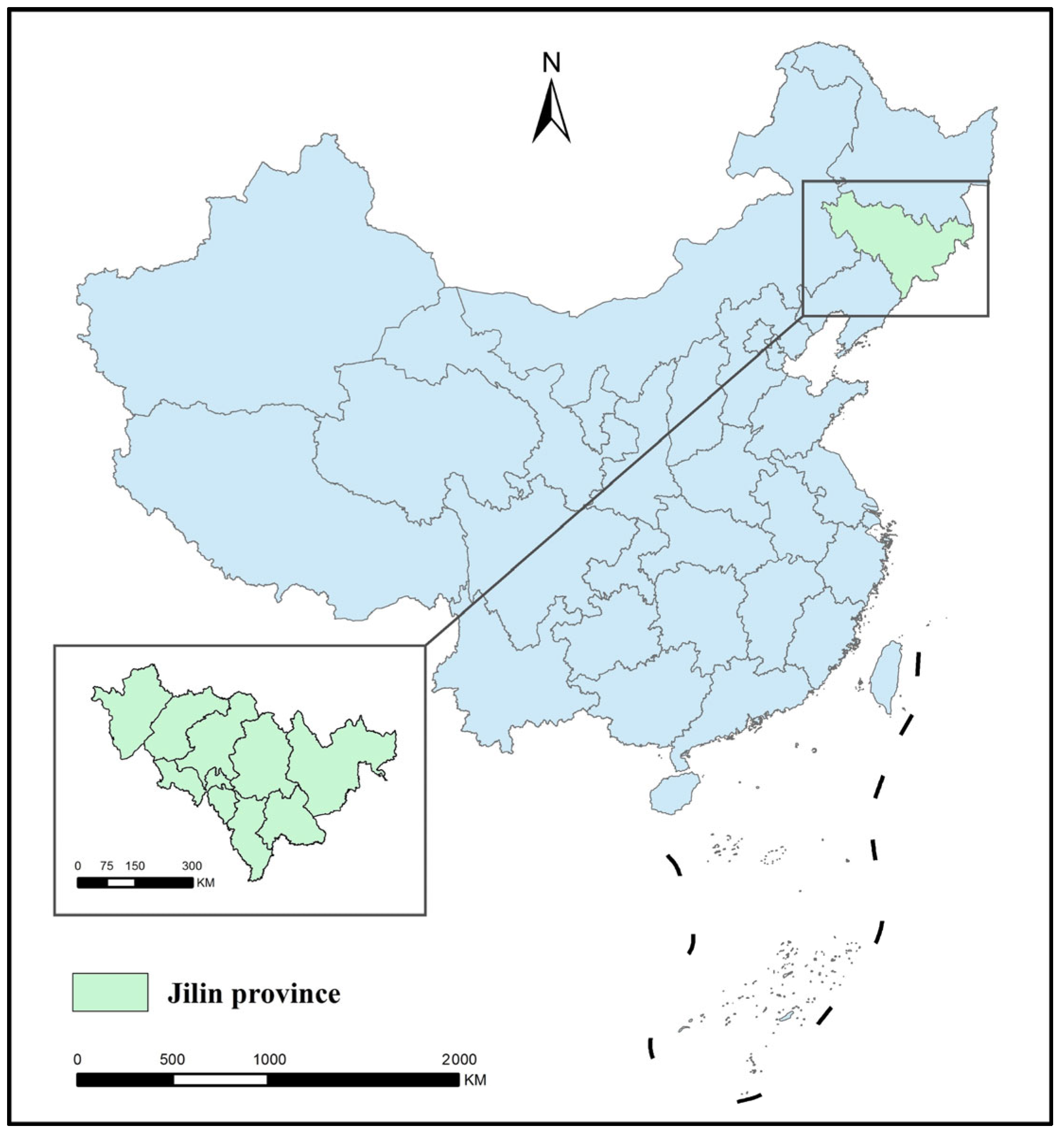
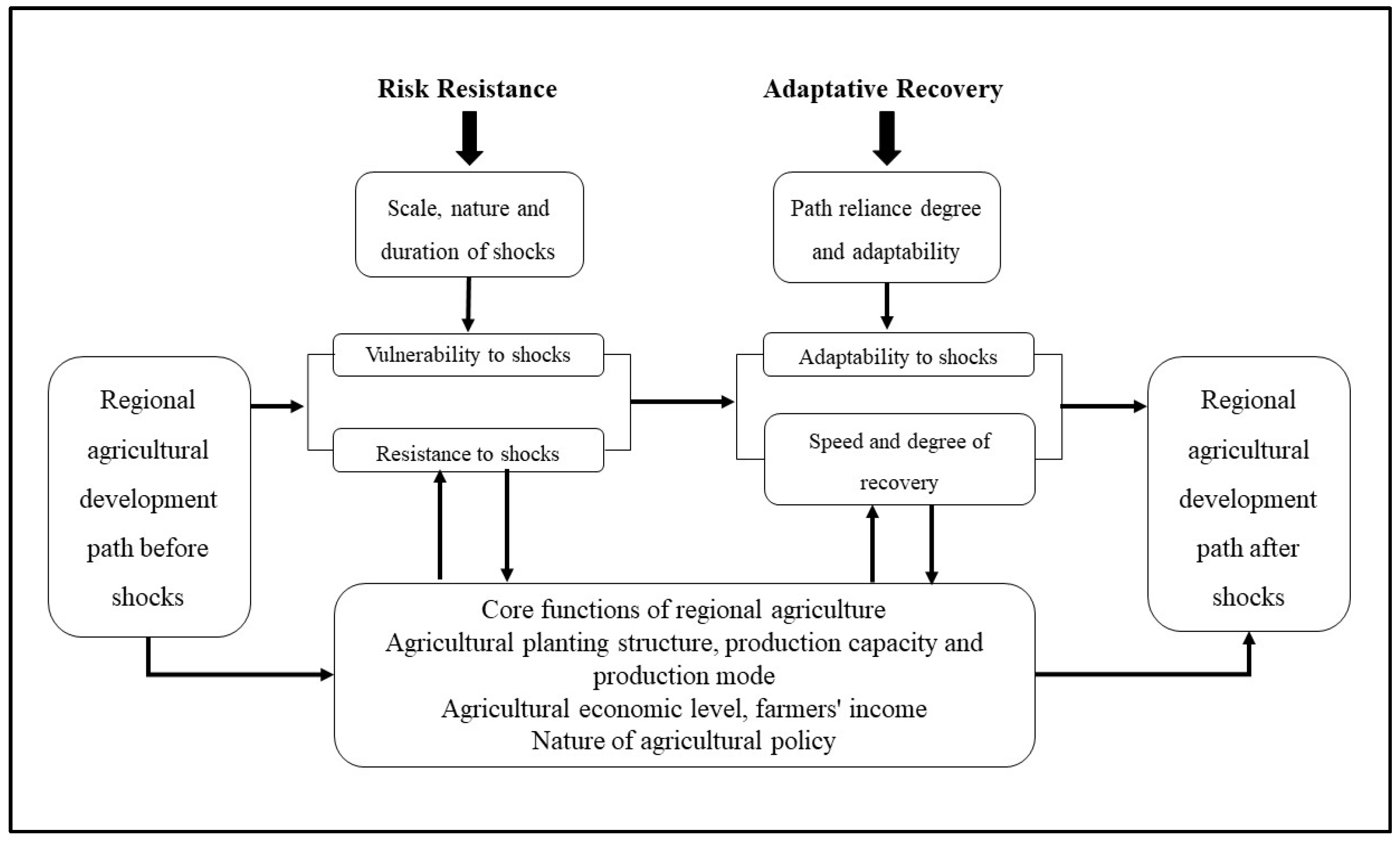
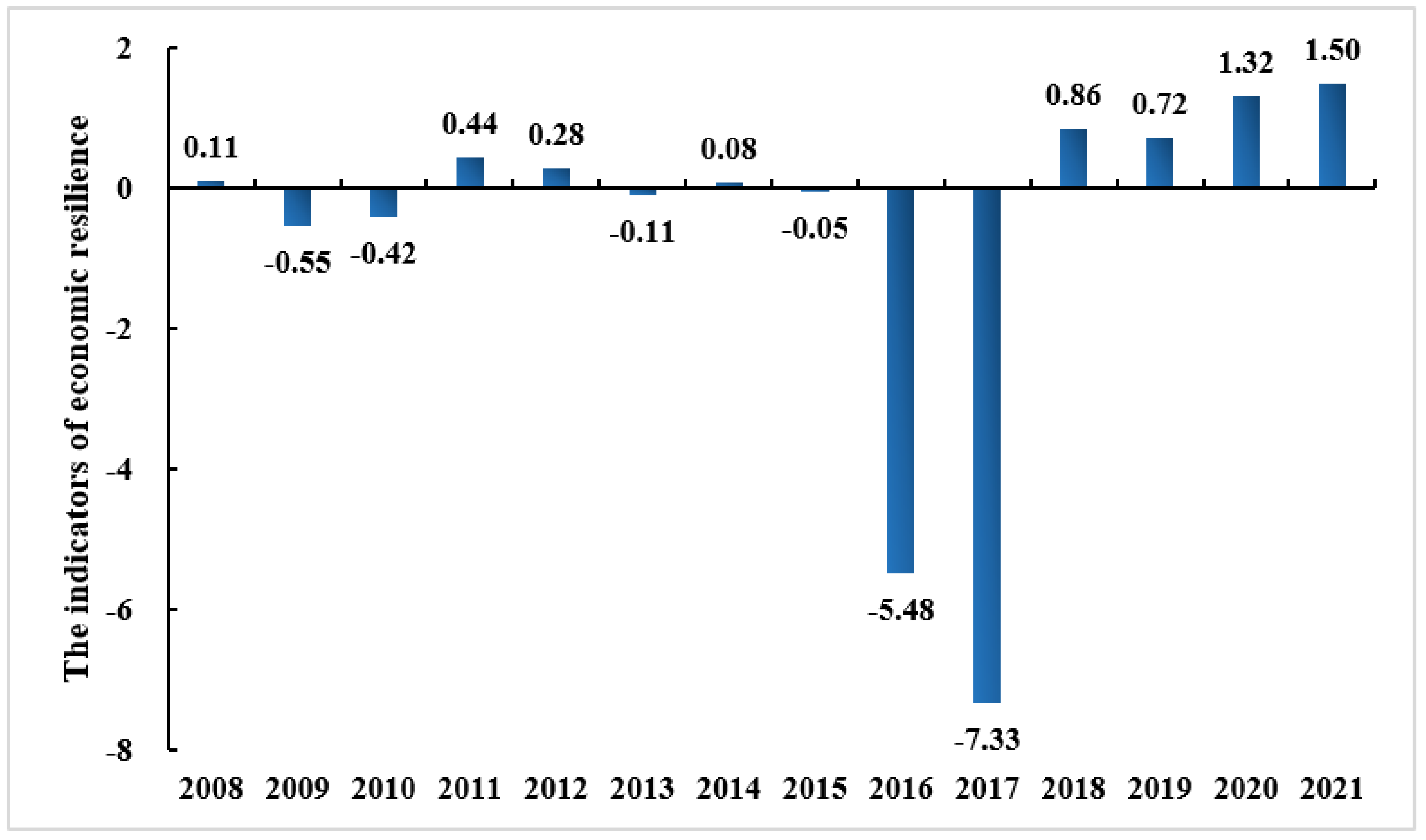
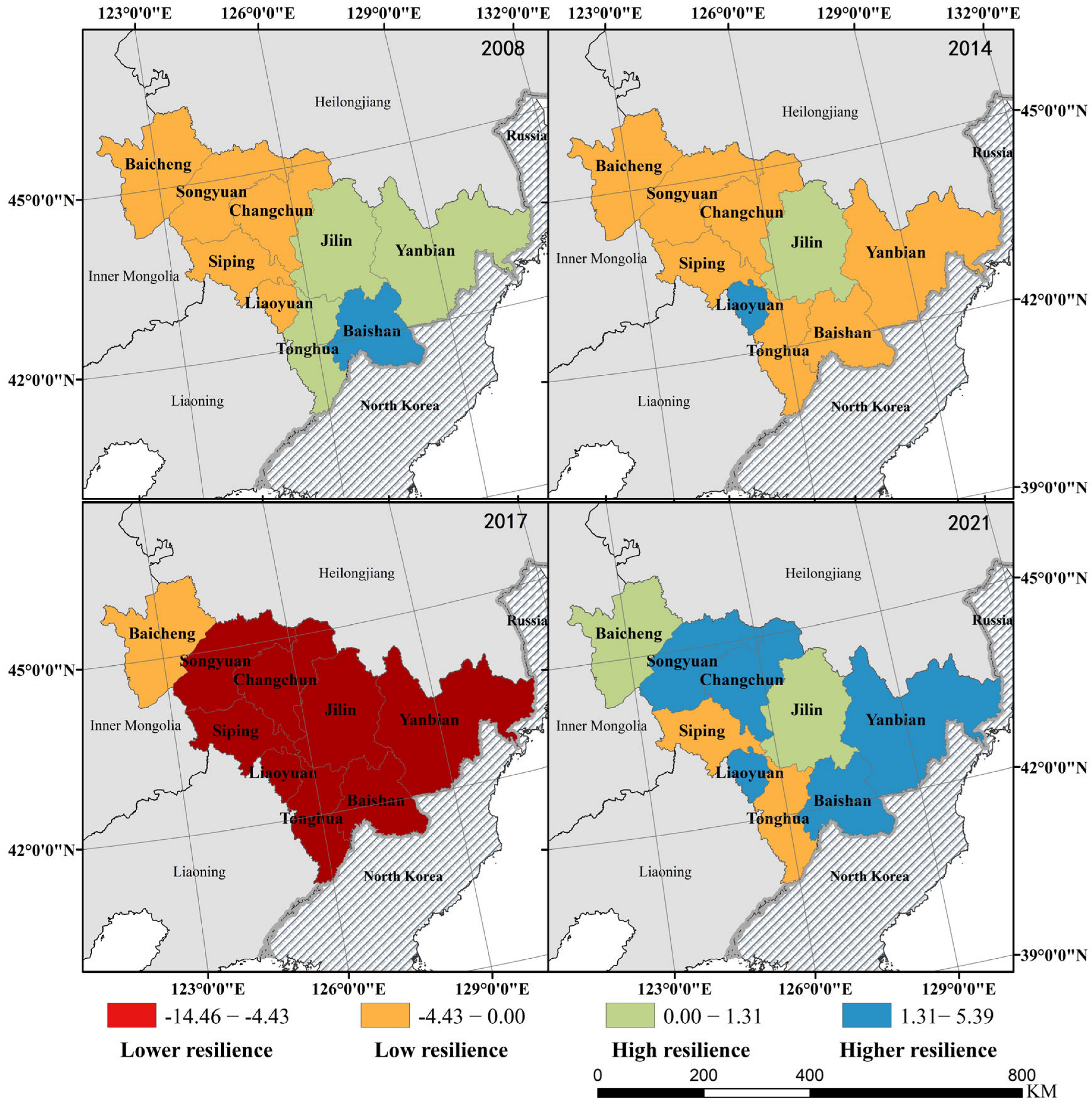
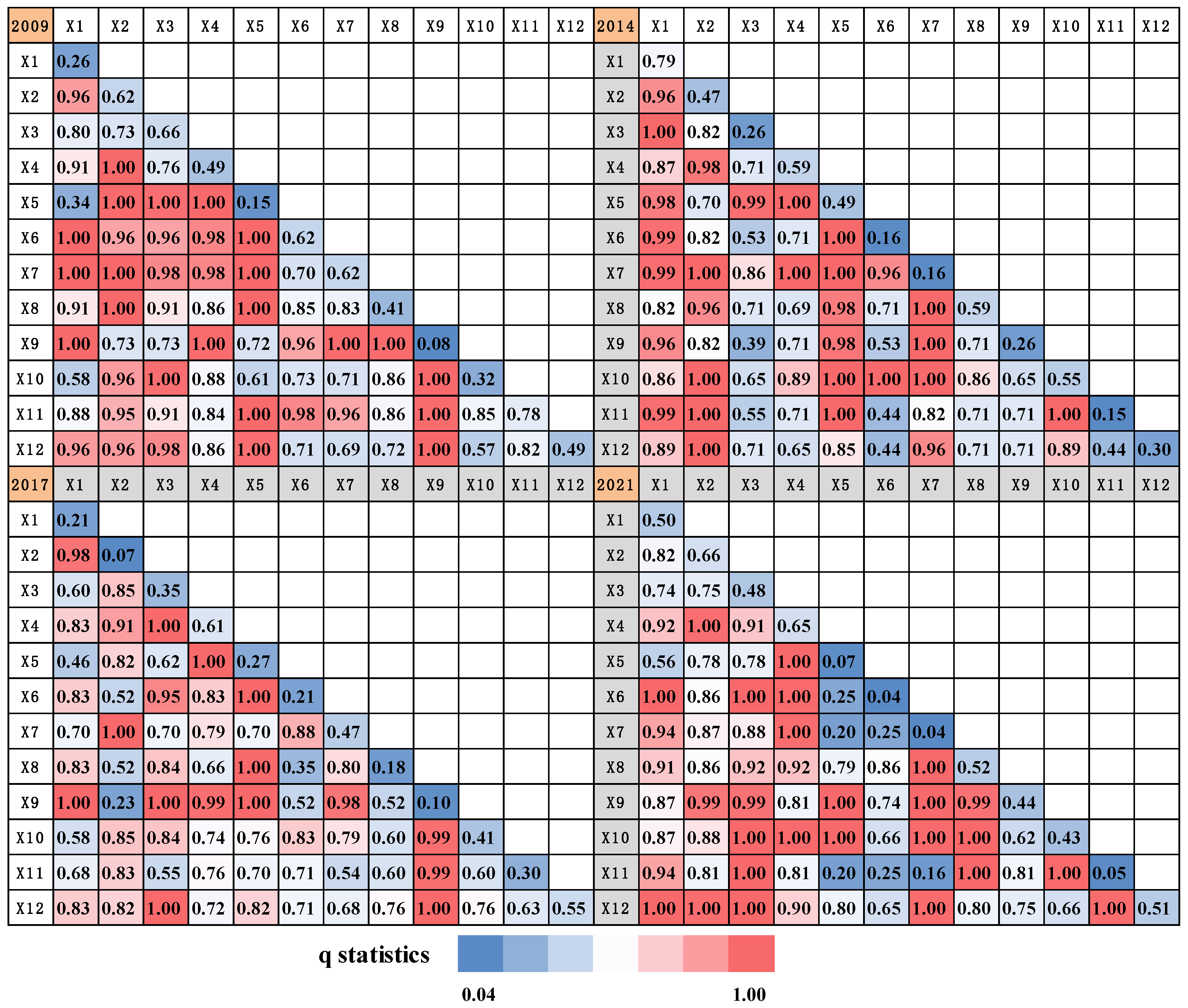
| Type of Variable | Influencing Factor | Calculation Method | Mean | Stdv | Min | Max |
|---|---|---|---|---|---|---|
| Government’s Support for Agriculture | Proportion of Agricultural Expenditure | Agriculture, forestry, and water affairs expenditure/Total government financial expenditure | 0.144 | 0.057 | 0.053 | 0.275 |
| Per Capita Agricultural Fixed Asset Investment | Agricultural fixed asset investment/Total agricultural population | 1.326 | 1.414 | 0.094 | 6.106 | |
| Agricultural Input Capacity | Degree of Mechanization | Total power of agricultural machinery/Cultivated land area at the end of the year | 5.084 | 1.280 | 2.670 | 9.130 |
| Proportion of Rural Agricultural Labor Force | Rural agricultural population/Total rural population | 0.423 | 0.086 | 0.308 | 0.655 | |
| Effective Irrigation Rate of Cultivated Land | Effective irrigation area/Cultivated land area at the end of the year | 0.236 | 0.130 | 0.029 | 0.489 | |
| Growth Rate of Corn Planting Area | Growth rate of corn planting area in the stage | 0.029 | 0.088 | −0.233 | 0.338 | |
| Agricultural Yield Capacity | Grain Yield Per Unit Area | Total grain yield/Cultivated land area at the end of the year | 6369.706 | 1514.816 | 3333.898 | 9146.272 |
| Scale of Agricultural Industry | Planting area of crops/Total agricultural population | 1.054 | 0.362 | 0.434 | 1.679 | |
| Agricultural Labor Productivity | Total agricultural output value/Total agricultural population | 2.515 | 0.762 | 1.317 | 4.033 | |
| Potential of Rural Market | Proportion of Rural Social Consumption | Total retail sales of consumer goods in rural areas/Total retail sales of consumer goods in the whole society | 0.118 | 0.035 | 0.061 | 0.205 |
| Urbanization Rate | Year-end urban population/Year-end total population | 0.504 | 0.125 | 0.270 | 0.746 | |
| Engel’s coefficient of rural residents | The proportion of total food expenditure of rural residents to total personal consumption expenditure | 33.752 | 6.091 | 24.800 | 45.600 |
| Type of Variable | Serial Number | Influencing Factor | 2009 | 2014 | 2017 | 2021 | Variation Trend |
|---|---|---|---|---|---|---|---|
| Government’s Support for Agriculture | X1 | Proportion of Agricultural Expenditure | 0.255 | 0.793 | 0.209 | 0.505 | ↑ |
| X2 | Per Capita Agricultural Fixed Asset Investment | 0.620 | 0.468 | 0.071 | 0.662 | ↑ | |
| Agricultural Input Capacity | X3 | Degree of Mechanization | 0.655 ** | 0.558 | 0.349 | 0.481 * | ↓ |
| X4 | Proportion of Rural Agricultural Labor Force | 0.510 | 0.590 | 0.614 * | 0.651 * | ↑ | |
| X5 | Effective Irrigation Rate of Cultivated Land | 0.509 | 0.490 | 0.265 | 0.068 | ↓ | |
| X6 | Growth Rate of Corn Planting area | 0.622 * | 0.463 | 0.214 | 0.043 | ↓ | |
| Agricultural Yield Capacity | X7 | Grain Yield Per Unit Area | 0.624 * | 0.464 | 0.471 | 0.044 | ↓ |
| X8 | Scale of Agricultural Industry | 0.527 | 0.588 | 0.175 | 0.520 * | ↑ | |
| X9 | Agricultural Labor Productivity | 0.078 | 0.259 | 0.104 | 0.441 | ↑ | |
| Potential of Rural Market | X10 | Proportion of Rural Social Consumption | 0.324 | 0.554 | 0.414 | 0.432 * | ↑ |
| X11 | Urbanization Rate | 0.780 * | 0.153 | 0.300 | 0.054 | ↓ | |
| X12 | Engel’s coefficient of rural residents | 0.426 | 0.296 | 0.654 * | 0.616 | ↑ |
Disclaimer/Publisher’s Note: The statements, opinions and data contained in all publications are solely those of the individual author(s) and contributor(s) and not of MDPI and/or the editor(s). MDPI and/or the editor(s) disclaim responsibility for any injury to people or property resulting from any ideas, methods, instructions or products referred to in the content. |
© 2023 by the authors. Licensee MDPI, Basel, Switzerland. This article is an open access article distributed under the terms and conditions of the Creative Commons Attribution (CC BY) license (https://creativecommons.org/licenses/by/4.0/).
Share and Cite
Yang, Q.; Zhang, P.; Li, Y.; Ning, J.; Chu, N. Does the Policy of Decoupled Subsidies Improve the Agricultural Economic Resilience?—Evidence from China’s Main Corn Producing Regions. Sustainability 2023, 15, 10164. https://doi.org/10.3390/su151310164
Yang Q, Zhang P, Li Y, Ning J, Chu N. Does the Policy of Decoupled Subsidies Improve the Agricultural Economic Resilience?—Evidence from China’s Main Corn Producing Regions. Sustainability. 2023; 15(13):10164. https://doi.org/10.3390/su151310164
Chicago/Turabian StyleYang, Qifeng, Pingyu Zhang, Yuxin Li, Jiachen Ning, and Nanchen Chu. 2023. "Does the Policy of Decoupled Subsidies Improve the Agricultural Economic Resilience?—Evidence from China’s Main Corn Producing Regions" Sustainability 15, no. 13: 10164. https://doi.org/10.3390/su151310164
APA StyleYang, Q., Zhang, P., Li, Y., Ning, J., & Chu, N. (2023). Does the Policy of Decoupled Subsidies Improve the Agricultural Economic Resilience?—Evidence from China’s Main Corn Producing Regions. Sustainability, 15(13), 10164. https://doi.org/10.3390/su151310164






